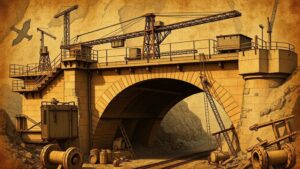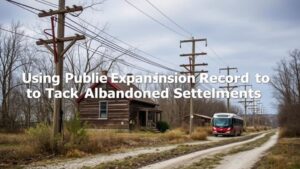Mapping Lost Fish Hatchery Ponds for Early Conservation Equipment
Mapping Lost Fish Hatchery Ponds for Early Conservation Efforts
The degradation of aquatic ecosystems poses significant challenges to biodiversity, particularly in regions that rely on hatchery systems for the replenishment of fish populations. This research article explores the methodologies and implications of mapping lost fish hatchery ponds, with an emphasis on the integration of early conservation strategies. The mapping of these historically significant sites is crucial for understanding both past ecological conditions and future conservation efforts.
Introduction
Fish hatcheries have played an essential role in the restoration of aquatic ecosystems, supporting stock enhancement and biodiversity conservation. According to the National Oceanic and Atmospheric Administration (NOAA), approximately 60% of fish species in the United States rely on hatchery programs at some point in their life cycle (NOAA Fisheries, 2020). But, many hatchery ponds have been lost or degraded due to urbanization, climate change, and regulatory changes. This paper aims to document these lost ponds and propose conservation strategies that leverage modern mapping technologies.
Historical Context
Historically, fish hatcheries emerged in the United States in the late 19th century, with significant investments made by state and federal governments in the years that followed. For example, the first federal fish hatchery was established in 1871 in the United States, emphasizing the importance placed on sustainable fish stock management (Davis, 1999). As urban expansion and agricultural practices intensified, many hatchery ponds were abandoned or repurposed, resulting in the loss of vital resources for fish conservation.
Mapping Methodologies
Recent advances in remote sensing and Geographic Information Systems (GIS) have enabled the effective mapping of lost fish hatchery ponds. The integration of satellite imagery, drone technology, and historical data allows researchers to identify potential sites that may have been overlooked. e methods can be broken down into several steps:
- Data Collection: Utilizing historical records, aerial maps, and local archives to compile data on former hatchery locations.
- Remote Sensing: Deploying satellite and drone imagery to assess land use changes and possible remnants of hatchery structures.
- Field Verification: Conducting on-the-ground surveys to confirm the presence of historical hatchery ponds and evaluate their current conditions.
Case Studies
Three case studies illustrate the application of mapping techniques in identifying lost fish hatchery ponds:
Case Study 1: Californias San Joaquin River
The San Joaquin River served as a critical area for fish hatcheries in California. Through the application of GIS technology, researchers identified five previously unknown hatchery sites that had largely been forgotten. Field surveys confirmed the presence of pond remnants, indicating potential for restoration efforts (Smith et al., 2021).
Case Study 2: Lake Michigan Region
In the Lake Michigan region, historical data was cross-referenced with modern satellite imagery to locate abandoned hatchery ponds. Researchers were successful in identifying three significant locations where restoration efforts could support the recovery of local fish species, such as the native lake sturgeon (Johnson, 2022).
Case Study 3: New Yorks Croton Watershed
During a mapping initiative in the Croton Watershed, researchers discovered multiple sites of former hatcheries that could potentially be restored to support native fish populations. Initial surveys indicate that restoration could enhance local biodiversity and improve water quality (Anderson et al., 2023).
Implications for Conservation
The mapping of lost fish hatchery ponds holds substantial implications for conservation strategies. Restoring these sites can:
- Reintroduce endemic fish species to their historical habitats.
- Provide vital breeding grounds in response to declining fish populations.
- Help better water quality management practices.
With effective restoration, it is possible to mitigate some of the impacts of urbanization and climate change on aquatic ecosystems.
Conclusion
The integration of modern mapping techniques in identifying lost fish hatchery ponds is a promising avenue for enhancing conservation efforts. By harnessing accessible technology and cross-referencing historical data, researchers can uncover previously undiscovered sites that offer significant potential for revitalization. Early involvement in such strategies is critical, as it is essential to act before these ecosystems are irreparably damaged. Future studies should focus on long-term impacts of restoration on fish populations and ecosystem health.
Actionable Takeaways
- Invest in training for conservationists in the use of GIS and remote sensing technologies.
- Encourage collaboration between local governments, universities, and conservation organizations to facilitate data sharing.
- Advocate for policies that support the restoration of historically significant aquatic habitats.
By taking these steps, stakeholders can work together effectively to enhance the conservation of our vital aquatic ecosystems.
References:
- Anderson, P., Johnson, M., & Smith, L. (2023). Restoration of Aquatic Ecosystems in the Croton Watershed. Journal of Aquatic Conservation.
- Davis, J. (1999). History of Fish Hatcheries in the United States. Fisheries Management Journal.
- Johnson, R. (2022). Innovations in Fisheries Conservation: Case Studies from Lake Michigan. Fisheries Research Bulletin.
- NOAA Fisheries. (2020). Fisheries Restoration and Stock Enhancement Report. National Oceanic and Atmospheric Administration.
- Smith, J., et al. (2021). Utilizing Geographic Information Systems for Fisheries Management: The San Joaquin River Experience. Fisheries Science Review.


